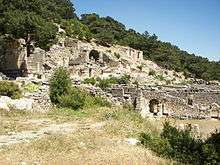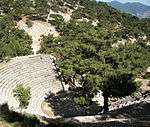Arycanda
Arycanda or Arykanda (Ancient Greek: Ἀρύκανδα) is an Ancient Lycian city, former bishopric and present Catholic titular see in Antalya Province in the Mediterranean Region of Turkey. Arykanda was built upon five large terraces ascending a mountain slope, located near the small village of Aykiriçay, presently on the Elmalı-Finike road.
Ἀρύκανδα | |
 The Roman baths (thermae) of Arykanda | |
 Shown within Turkey | |
| Alternative name | Arykanda |
|---|---|
| Location | Aykiriçay, Antalya Province, Turkey |
| Region | Lycia |
| Coordinates | 36°30′50″N 30°03′36″E |
| Type | Settlement |
History
Arycanda is known to be one of the old Lycian cities, as its name ends with -anda, indicative of its Anatolian origin; dating back as far as the 2nd millennium BC.[1]
On the other hand, the oldest remains and finds from the city date from the 6th or 5th century BCE. The site is being excavated and restored by an Ankara University team[1] headed by Prof. Dr. Cevdet Bayburtluoglu[2] since 1971.
Gods and goddesses known to have been worshipped here are: (mostly Greek)
- Aphrodite
- Apollo
- Ares
- Artemis
- Asklepios
- Athena
- Helios
- Hera
- Heracles
- Hermes
- Hygeia
- Kakasbos (an Anatolian horseman-deity)
- Mithras (Persian)
- Nemesis
- Somendeus (a mountain god)
- Tyche
Arycanda survived through Byzantine times, until the 6th century when the settlement moved to a new site south of the modern road, which is called Arif (or Aruf) Settlement in archaeological literature so that it will not mix up with the older site.
Sights

Acropolis houses Hellenistic and older remains of the site which include the temple of Helios, bouleterion, prytaneion, upper agora withs its shops, and several excavated houses. The lower city houses most of the Roman remains. These include:
- A bath complex on the lowest terrace, still virtually intact in its sequence of arches, next to the gymnasium. The city has 7 different bath houses of various sizes.
- Lower Agora, some of the shops in its eastern part can still be seen. It is wide and flat, located to the south of the odeon and was enclosed on three sides by a portico. At its middle are the remains of Tyche Temple.
- A theatre, in excellent condition, built during the 1st century BCE. It has 20 rows of seats, divided into 7 sections. At the edge of every row are holes that were used to support protective awnings.
- Odeon - 2nd century AD. The main entrance is to the south, through a triple portal. This was once a very ornate building, the interior was lined with orthostats and the walls, orchestra and seats were once covered with coloured marble. A block that was discovered (and now housed in Antalya Archaeological Museum) during the excavations over the portal bears a portrait of the Emperor Hadrian.
- A stadium, from the Hellenistic period, that resides above the theatre, in the form of a running track with seats built only on one side. It is smaller than a usual stadium, measuring 106 m. long and 17 m. wide.
- Two necropoleis. The one on the entrance to the site is very interesting with its series of richly decorated funerary monuments. The eastern necropolis has barrel-vaulted monumental tombs, temple-tombs and sarcophagi and the western necropolis has rock-cut tombs and barrel-vaulted tombs.
Ecclesiastical history
Former diocese
Since it was in the Roman province of Lycia, the bishopric of Arneae was a suffragan of the metropolitan see of Myra, the province's capital. The Second Council of Nicaea (787) were signed on behalf of the absent bishop of Arycanda by his deacon Petrus. Another bishop of Arycanda, Theodorus, took part in the Photian Council of Constantinople (879).[3][4]
Titular see
No longer a residential bishopric, Arycanda is today listed by the Catholic Church as a titular see.[5]
It is presently vacant, having had the following incumbents since the diocese wasnominally restored in 1921, under the name Aucanda/Ascanda until 1925, all of the lowest (episcopal) rank :
- Sotero Redondo Herrero, Augustinian Order (O.E.S.A.) (1921.06.16 – 1935.02.24)
- Anunciado Serafini (1935.05.11 – 1939.06.20)
- Jean Larregain (甘有為), Paris Foreign Missions Society (M.E.P.) (1939.06.13 – 1942.05.02)
- Joseph Martin Nathan (1943.04.17 – 1947.01.30)
- Antônio Maria Alves de Siqueira (1947.05.10 – 1957.07.19) (later Archbishop)
- Francisco Ferreira Arreola (1957.12.21 – 1960.08.01)
- Benito Epifanio Rodríguez (1960.09.23 – 2001.02.15)
Gallery
 Theater
Theater Arycanda Theatre panorama
Arycanda Theatre panorama Arycanda Theatre panorama
Arycanda Theatre panorama Grave decorated with a gorgon head
Grave decorated with a gorgon head Roman mosaic floor
Roman mosaic floor Arykanda general view
Arykanda general view Arycanda from within bath
Arycanda from within bath Arycanda Peristyle house
Arycanda Peristyle house Arykanda Peristyle house mosaic
Arykanda Peristyle house mosaic Arykanda Peristyle house mosaic
Arykanda Peristyle house mosaic Arykanda Peristyle house mosaic
Arykanda Peristyle house mosaic Arykanda State agora
Arykanda State agora Arykanda Basilica mosaic
Arykanda Basilica mosaic Arykanda Odeon
Arykanda Odeon Arycanda Traianeum
Arycanda Traianeum Arycanda at stadion
Arycanda at stadion Arykanda Stadion
Arykanda Stadion Arykanda Tomb 1
Arykanda Tomb 1 Arykanda Monumental grave
Arykanda Monumental grave Monumental grave entrance detail
Monumental grave entrance detail
Notes
- Whiting, Dominic (2000-04-01). Turkey Handbook: The Travel Guide. Footprint Handbooks. p. 365. ISBN 1-900949-85-7.
- Harrison, Martin (2001-09-05). Mountain and Plain: From the Lycian Coast to the Phrygian Plateau in the Late Roman and Early Byzantine Period. p39. University of Michigan Press. ISBN 0-472-11084-5.
- Michel Lequien, Oriens christianus in quatuor Patriarchatus digestus, Paris 1740, Vol. I, coll. 993-994
- Pius Bonifacius Gams, Series episcoporum Ecclesiae Catholicae, Leipzig 1931, p. 450
- Annuario Pontificio 2013 (Libreria Editrice Vaticana 2013 ISBN 978-88-209-9070-1), p. 838
External links
| Wikimedia Commons has media related to Arycanda. |